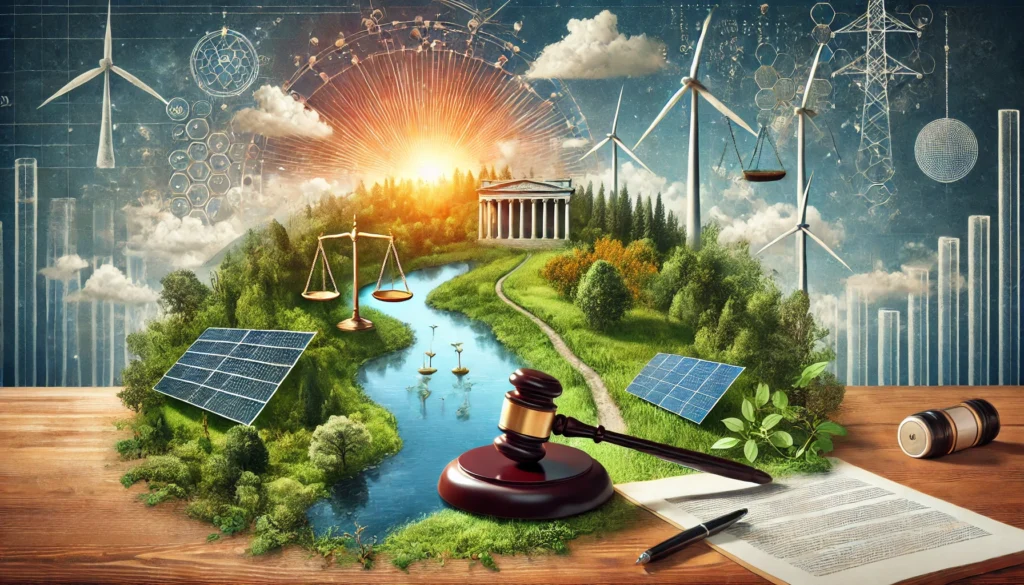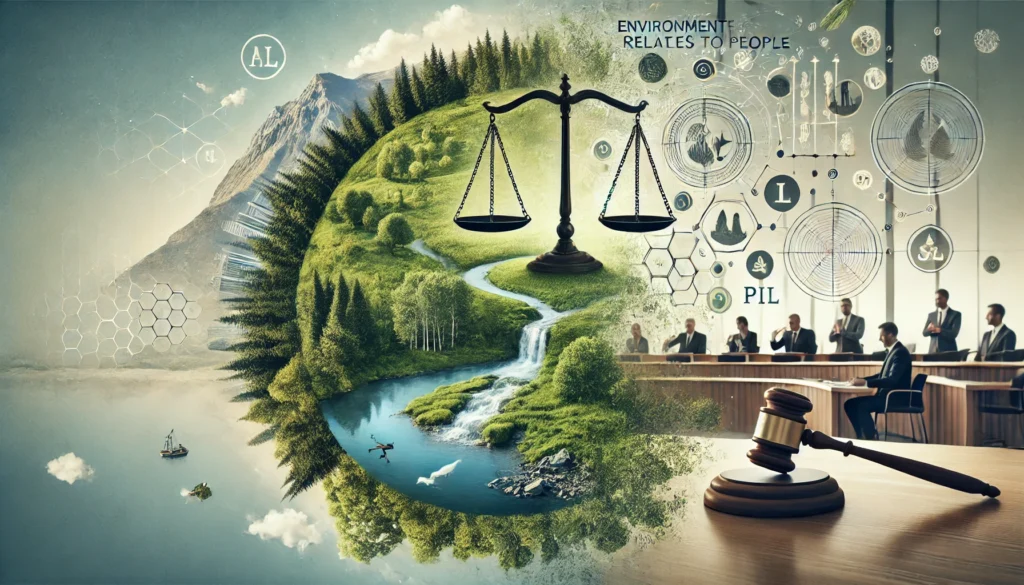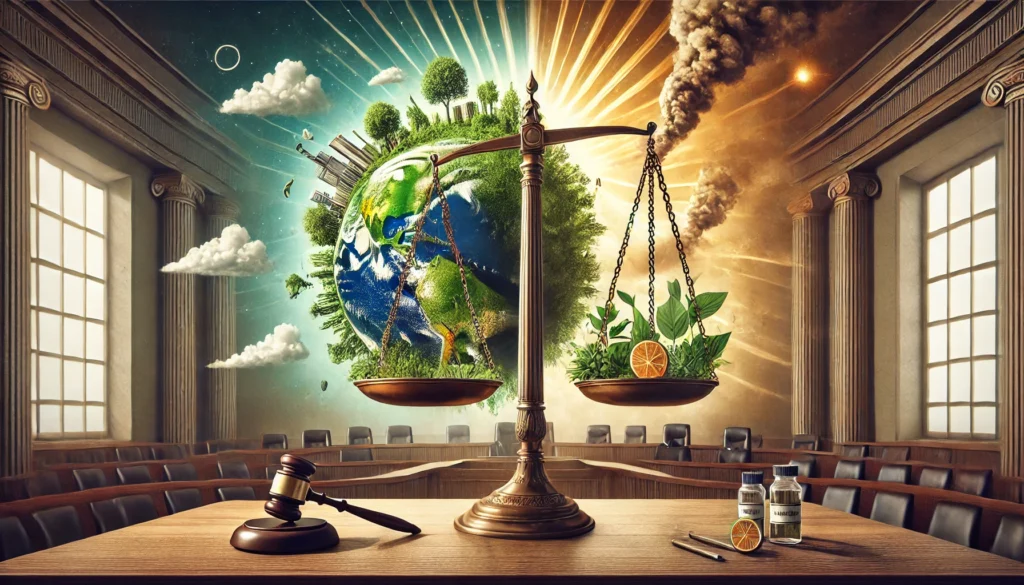Published on 9th February 2025
Authored By: Adnan Siraj
Universitas Jmabi, Jambi Indonesia
Abstract
This paper examines both the national and global frameworks for addressing climate change, with special emphasis on the legal and policy responses of Indonesia. It examines international agreements surrounding climate, such as the Paris Agreement, and what they mean for national strategies. The progress and challenges faced by Indonesia in meeting its climate targets are assessed regarding Indonesia’s climate policies including the Forest Moratorium and the renewable energy targets. Based on literature review, the study pinpoints coal use, deforestation and weak governance as some key barriers to transformation of the power system from coal to renewables, and provides insight into how increased implementation of policy enforcement, quickening the transition of renewable power and synergies between international cooperation can help in addressing them. The methodology, which comprises qualitative analysis of policy documents, international agreements and academic literature, is coupled with a comparison of successful climate strategies in other nations.
Introduction
One of the most pressing challenges of the 21st century is climate change its far reaching implications for ecosystems, economies and societies. A changing climate increases global temperatures, melts ice caps, leads to extreme weather events, and threatens biodiversity loss all as a result of human caused greenhouse gas emissions. This crisis must be addressed with a global coordinated effort driving resilience through mitigation and adaptation based on robust legal frameworks and policies.
Underpinned by the seminal international climate governance agreement, from the United Nations Framework Convention on Climate Change (UNFCCC) and its consequential leading agreements at the Kyoto Protocol and Paris Agreement, international climate governance exists at the core. These frameworks set binding and nonbinding commitments by which nations are supposed to lower emissions and move toward sustainability.[1] While global commitments have been long made and while great strides have been made toward the practice of the lofty document in recent decades, much work still lies ahead when it comes to translating those commitments into national policy actions, and especially for developing nations.
As an archipelagic nation, comprising of more than 17,000 islands that are highly vulnerable to the potential damages of the adverse impacts of climate change, Indonesia is semi susceptible to the adverse impacts of the climate change. However, rising sea levels, increases in the frequency of natural disasters, disruptions to agriculture and fisheries all represent threats to its population numbers and economy. Indonesia, as a country of the signatory of the Paris Agreement has committed to cut greenhouse gas emission by 29% unconditionally and 41% with the international aid, by 2030.[2] To these ends, Indonesia has passed a plethora of laws and policies that included its Nationally Determined Contributions (NDCs), renewable energy goals, as well as measures to stem decreasing deforestation.
In this article, the article explores the relationship between global climate change frameworks and Indonesia’s national response that examine effectiveness, challenges, and prospects of climate governance. It endeavors both from the international and domestic perspectives to illuminate the legal and policy mechanisms needed to respond effectively to this global crisis.
Global Legal Frameworks on Climate Change
A set of international legal frameworks and agreements set the terms of the global response to climate change by requesting nations to mitigate and adapt to its impacts. This explains these frameworks, which set principles, targets, and mechanisms of cooperation, aimed to limit the global temperature rise and take under development. The nucleus of the system of international climate governance is the United Nations Framework Convention on Climate Change (UNFCCC) of 1992. Because it enjoys near universal membership, the UNFCCC also establishes the framework for collective action through the principle of ‘common but differentiated responsibilities and respective capabilities’ (CBDRRC). This recognizes that developed and developing nations have different capabilities to respond to climate change.[3]
The Kyoto Protocol, set up in 1997, continues the UNFCCC by setting legally binding emissions reduction targets for industrialized nations. The protocol came into force in 2005, and during its first commitment period (2008–2012) was designed to reduce greenhouse gas emissions by 5% below 1990 levels. The Kyoto Protocol represented a big step but was beset by criticism for not including major emitters such as the United States, and for the limited impact on global emissions.[4] In 2015, the Paris Agreement is a paradigmatic change in global climate governance. Unlike previous agreements, it takes a bottom up approach which allows countries to opt their own Nationally Determined Contributions (NDCs) to cut emissions. The deal seeks to place worldwide warming below 2°C beyond prevailing levels, while attempting to stay just below 1.5°C. Also, there are mechanisms of transparency, adaptation, and the financial support, on the basis of which it can be called a comprehensive framework to the problem solving of climate change.[5] Beyond these agreements there are other initiatives that supplement global efforts. Initially used as a tool to protect the ozone layer, the Montreal Protocol has helped dramatically reduce use of hydrofluorocarbons (HFCs), potent greenhouse gases. Similarly, the Sustainable Development Goals (SDGs) particularly, goal 13, put forward climate action as a key component of global development.[6] Yet, significant progress has not been achieved. Full implementation of these frameworks is holding back because of political disagreements, inadequate funding and disparities in capacity. Yet the withdrawal and re-entry of countries such as United States from the Paris Agreement highlight how fragile international climate consensus.[7]
Collective action is led in the global legal frameworks on climate change. Such effectiveness depends however on strong political will, equitable resource distribution, and improved cooperation by nations. Ambiance as the climate crisis grows stronger, a priority to reinforce these frameworks where they have been and ensure their strong application whenever cast.
Indonesia’s Climate Change Laws and Policies
As one of the world’s greatest archipelagic nations, Indonesia is challenged by climate change with rising sea levels, more frequent natural disasters, and biodiversity threats. Knowing this, Indonesia has been taking a number of laws, policies, and initiatives to handle climate change through the lens of international frameworks including Paris Agreement. Indonesia’s Nationally Determined Contributions (NDCs) under the Paris Agreement are one of the cornerstone policies. However, the NDCs detail Indonesia’s intent to reduce greenhouse gas (GHG) emissions by 29 unconditionally and 41 with international support by 2030. At the core, providing protection to reduce deforestation, restore peatlands, and transition to renewables.[8] This is established within a legal provision for environmental issues including climate change as stipulated by the Environmental Protection and Management Act (Law No. 32/2009). The literature stresses sustainable development and provides guidelines for pollution control, natural resources conservation and environmental impact assessment.[9] To address both deforestation and forest degradation Indonesia adopted in 2011 its Forest Moratorium Policy, which puts a pause on the issuance of new permits for primary forest and peatland exploitation. And this policy has been extended several times and is crucial in limiting emissions on land use changes, a major part of country’s GHG emissions.[10]
Therefore, Indonesia has also adopted ways to develop renewable energy, during its national energy policy – Law No. 30/2007 and subsequent regulations. Their aim is to raise the share of renewable energy in the national energy mix to 23 percent by 2025, using mostly solar, wind and geothermal power. While progress towards achieving this target has proceeded more slowly than hoped due to financial and technical challenges.[11] Furthermore, LCDI, a national development planning approach for incorporating climate change to national development planning, has also been put in place by the government. So the object is to balance economic growth with environmental sustainability by putting low carbon policies on top.[12]
However, there continue to be challenges. The deforestation rates are simply too high, and reliance on coal for energy production has prevented Indonesia from making a transition to a low carbon economy. First, climate policies are handicapped by limited financial resources, governance problems, and weak enforcement mechanisms.[13] By the laws and policy with regard to climate change, it means that Indonesia is ready to tackle this global crisis. While making the bold targets achievable will rely on stronger governance, increased international cooperation, and increased investment in sustainable development.
Comparative Analysis: Global vs. National Approaches
To fight climate change, we must all work together, at the global and national levels. Although global frameworks establish high level guidance and commitments, at the national level there must be local nuanced, varying and realities. Indonesia’s efforts on climate change evidences the openings and restrictions of matching the national strategy to international commitments. Since global frameworks like the Paris Agreement encourage us to think bottoms up, countries can develop Nationally Determined Contributions (NDCs) that take their circumstances into account. For Indonesia, that has meant a commitment to cut greenhouse gas (GHG) emissions by 29 per cent by 2030 and up to 41per cent, with international help. The global consensus on the urgency of climate action, Indonesia’s development needs, are reflected in this commitment.[14]
There nonetheless are deep gaps between global ambitions and national translation. For example, while the Paris Agreement supports a switch to renewable energy Indonesia continues to depend on coal for supplying energy. Nevertheless, progress has been slow to meet a target of 23% renewable energy in its energy mix by 2025, mainly due to financial and infrastructural restrictions.[15] However, they find that developed nations have advanced further into renewable energy uptake, thanks to the backing of powerful technologies and funding, than less developed ones. There is a second divergence, that of deforestation. Indonesia’s Forest Moratorium Policy aligns with forest conservation initiatives such as REDD+ (Reducing Emissions from Deforestation and Forest Degradation), which incentivize global initiatives to conserve forest. But its effectiveness is hampered by high rates of illegal logging and land use changes in Indonesia. On the other hand, nations did succeed in lowering deforestation, for example, nations like Brazil have done so with a requirement of stricter enforcement and community engagement.[16]
There is still plenty to be bridged financially or technically. Based in Jakarta and funded in whole or in part through the work of major members like California and the European Union governments and cities that are directly responsible for the bulk of this country’s emissions CEE projects provide a model for other developing nations, including Indonesia, to implement climate policies. But, to access these funds often means complicated procedure at the local level. The global focus on sustainable development and the efforts to include climate action in Indonesia’s national development plans, for example, the carrying out of Low Carbon Development Initiative (LCDI), are also happening. But doing this calls for stronger governance, capacity building, and public private partnerships.
Challenges and Future Prospects in Climate Policy Implementation in Indonesia
Indonesia has made ambitious pledges to address the climate challenges outlined by international frameworks like the Paris Agreement, growing concerns prevail about its capacity to meet the nation’s climate goals. Indonesia is one of the world’s largest coal exporters, and the country’s dependence on coal makes it a major barrier. Despite the inclusion of renewable energy targets in the National Energy Policy, the transition from coal has been slow for high cost, insufficient infrastructure, and strong vested industry interests of the fossil fuel industry.[17] The reliance on coal hinders Indonesia to meet its climate targets. Another critical issue in deforestation. One of the world’s highest rates of deforestation, Indonesia’s deforestation is largely caused by agricultural expansion, illegal logging and land conversion to palm oil plantations. The Forest Moratorium Policy has stopped some new deforestation in some areas, but enforcement has been difficult. Land conversion is widespread despite efforts to reduce greenhouse gas emissions associated with deforestation.[18] This adds a further layer to Indonesia’s already vast problem of deforestation one which makes the task of reducing carbon output and hitting climate targets even more difficult. In addition, Indonesia’s governance structures make it difficult for policy to be implemented. Delays and inconsistencies at the enforcement of policy are encouraged by the corruption, weak law enforcement, and lack of coordination between local and national authorities. Such fragmented efforts resulting from the decentralized governance system often result in poor policy execution hampering climate action.[19]
Addressing these challenges requires more political will, better governance, greater international support, higher investment in renewable energy and in sustainable practices, and a better plan of conduct in many other policies. Overcoming these barriers will be influenced by increasing efforts in policy enforcement and integrating climate action into all sectors of development.
In terms of the future, Indonesia needs to look at climate change from a multiple perspective based on the global cooperation towards strong national strategies. Indonesia needs policy enforcement that is clearer and better integration of climate action across the national development sectors. In addition, there is an improvement to the way key policies are implemented, particularly, the Forest Moratorium and the renewable energy targets, increasing monitoring and evaluation mechanisms to promote greater accountability and transparency.[20] But accelerating the transition to renewable energy will cut reliance on coal. International organizations and private investors, at least some of which are investing in renewable energy technologies such as solar, wind and geothermal, are investing in renewable energy technologies for alignment of national energy policies with the global Paris Agreement.[21]
Financial and technical resources will only be secured through international cooperation, through programs such as the Green Climate Fund (GCF) and REDD+. Best practices from the success of climate policies in other countries, for instance Brazil’s deforestation efforts, can contribute valuable lessons for Indonesia.[22] And it is important to promote community based climate action as well. It is important for local communities to take the lead in climate initiatives and engage in public awareness, public education and practice of sustainability including integration of indigenous knowledge on forest and peatland management.[23] However, Indonesia’s future climate resilience will be built upon bold action, innovation, and intensified international collaboration to see the country reach its climate goals and help accelerate global efforts to combat climate change.
Conclusion
With each passing day of growing climate impacts, we need workable legal and policy frameworks to mitigate for and adapt to changing climate. Because global agreements like the Paris Agreement have set such ambitious targets for tackling greenhouse gas emissions, we want to get UNFCCC to evolve their approach and ensure their projects make connections to the implementation of the Paris Agreement and the Sustainable Development Goals. However, the success of these frameworks largely rests on national implementation and countries like Indonesia must close the gap between what is international and what feels here. As an economically developing nation, sensitive to climate change, Indonesia faces multiple challenges in sustaining economic development and environmental sustainability. While climate policy formulation has made significant progress in the form of the Nationally Determined Contributions and the Forest Moratorium, implementation is held back by challenges from deforestation, fossil fuel dependence, and scarce resources of money. But there are areas of concern the country continues with high reliance on coal, and there is little progress in the adoption of renewable energy. But there are many good opportunities. If still aiming to achieve this, Indonesia is encouraged to strengthen the integration of climate action in national development plans, scale up renewables in its own atmospheric space, and legitimize international cooperation. Second, promoting community based approaches combined with indigenous knowledge, as well as bringing about more inclusive and effective governance structures, can be used to further promote more inclusive and effective climate policies.
Finally, Indonesia’s response to climate change offers a look into both challenges and opportunities for countries trying to cooperate in a global climate governance. Indonesia can help drive change by bringing national efforts in line with international frameworks and committing to sustainable development, in a way that will contribute to a more resilient and more sustainable world for its people and planet.
References
[1] Brian Dawson & Matt Spannagle, United Nations Framework Convention on Climate Change (Unfccc), in The complete guide to climate change 392 (2008).
[2] Satria Putra Kanugrahan & Dzikri Firmansyah Hakam, Long-Term Scenarios of Indonesia Power Sector to Achieve Nationally Determined Contribution (NDC) 2060, 16 Energies 4719 (2023).
[3] Dawson and Spannagle, supra note 1.
[4] United Nations, Kyoto Protocol to the United Nations Framework Convention on Climate Change (1998).
[5] Paris Agreement, Paris Agreement, 4 2 (2015).
[6] Montreal Protocol, Montreal Protocol on Substances That Deplete the Ozone Layer, 26 Washington, DC: US Government Printing Office 128 (1987).
[7] Noah M Sachs, The Paris Agreement in the 2020s: Breakdown or Breakup, 46 Ecology lq 865 (2019).
[8] Kanugrahan and Hakam, supra note 2.
[9] Oheo K Haris, Legal Environmental Action Aspects, Based on Environmental Conservation, According to Law 32/2009 Concerning Protection and Management of Environment127 (2019).
[10] Daniel Murdiyarso et al., Indonesia’s Forest Moratorium, 76 A stepping stone to better forest governance (2011).
[11] Energy Law No. 30/2007 – Policies, https://www.iea.org/policies/1858-energy-law-no-302007.
[12] Alin Halimatussadiah et al., INDONESIA’S DECARBONIZATION PLANS DIAGNOSTIC: A POLICY PAPER (2024).
[13] Ika Sri Hastuti, Assessing Indonesia’s Enhanced Nationally Determined Contributions (NDC) to The Paris Agreement: Identifying The Obstacles Indonesia Has in Addressing Climate Change154 (2024).
[14] Kanugrahan and Hakam, supra note 2.
[15] Id.
[16] Celso HL Silva Junior et al., The Brazilian Amazon Deforestation Rate in 2020 Is the Greatest of the Decade, 5 Nature ecology & evolution 144 (2021).
[17] Energy Law No. 30/2007 – Policies, supra note 11.
[18] SangKyung JANG & Jae Soo BAE, An Analysis of Indonesia Forest Moratorium: With Particular Reference to Forest Governance, 23 The Southeast Asian review 49 (2013).
[19] Nila Kamil, Simon R Bush & Aarti Gupta, Does Climate Transparency Enhance the Reflexive Capacity of State Actors to Improve Mitigation Performance? The Case of Indonesia, 9 Earth System Governance 100111 (2021).
[20] Energy Law No. 30/2007 – Policies, supra note 11.
[21] JANG and BAE, supra note 18.
[22] Silva Junior et al., supra note 16.
[23] Carolyne Nyaboke Musembe & James Onyango, 26. Integrating Indigenous Knowledge in Climate Change Adaptation Strategies: A Literature Review, Indigenous Knowledge and Sustainable Development 295.



